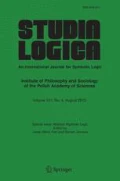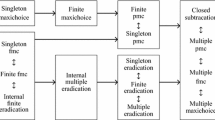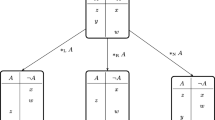Abstract
We can often specify how we would contract by a certain sentence by saying that this contraction would coincide with some other contraction that we know how to perform. We can for instance clarify that our contraction by p&q would coincide with our contraction by p, or by q, or by {p, q}. In a framework where the set of potential outcomes is known, some contractions are “self-evident” in the sense that there is only one serious candidate that can be the outcome of such a contraction. Contraction by a specific contractee (sentence or set of sentences to be contracted) is bootstrapped if it is specified by saying that it coincides with some such self-evident contraction. For a wide range of (multiple) contraction operators, contractions by any contractee can be bootstrapped. This means that the selection mechanism (selection function, incision function, etc.) can be replaced by a function called a bootstrapping selector that assigns to each contractee some “self-evident” contractee that yields the same outcome. With bootstrapping we can eliminate traditional extralogical components in contraction (e.g., selection functions) and replace them by bootstrapping selectors that reflect more closely the ways in which we actually reason and argue about belief contraction.
Similar content being viewed by others
References
Alchourrón C., Gärdenfors P., Makinson D.: On the logic of theory change: partial meet contraction and revision functions. Journal of Symbolic Logic 50, 510–530 (1985)
2. Alchourrón, C., and D. Makinson, Hierarchies of regulation and their logic, in R. Hilpinen (ed.), New Studies in Deontic Logic, Reidel, Dordrecht, 1981, pp. 125–148.
Alchourrón C., Makinson D.: On the logic of theory change: contraction functions and their associated revision functions. Theoria 48, 14–37 (1982)
Alchourrón C., Makinson D.: On the logic of theory change: safe contraction. Studia Logica 44, 405–422 (1985)
Areces, C., and V. Becher, Iterable AGM functions, in M.-A. Williams and H. Rott (eds.), Frontiers in Belief Revision, Kluwer, Dordrecht, 2001, pp. 261–277.
Arló Costa, H., and A. P. Pederson, Bounded rationality: models for some fast and frugal heuristics, in J. van Benthem, A. Gupta, and E. Pacuit (eds.), Games, Norms and Reasons, Synthese Library 353, Springer, Dordrecht, 2011, pp. 1–21.
Fermé, E., and S. O. Hansson, Shielded contraction, in H. Rott and M.-A. Williams (eds.), Frontiers of Belief Revision, Kluwer, Dordrecht, 2001, pp. 85–107.
Fermé E., Krevneris M., Reis M.: An axiomatic characterization of ensconcement-based contraction. Journal of Logic and Computation 18, 739–753 (2008)
Fermé E., Saez K., Sanz P.: Multiple kernel contraction. Studia Logica 73, 183–195 (2003)
Fuhrmann A., Hansson S.O.: A survey of multiple contractions. Journal of Logic, Language and Information 3, 39–76 (1994)
Gigerenzer, G., and R. Selten, (eds.), Bounded Rationality: The Adaptive Toolbox. MIT Press, Cambridge, MA, 2001.
Hansson, S. O., A dyadic representation of belief, in P. Gärdenfors (ed.), Belief Revision, Cambridge University Press, Cambridge, 1992, pp. 89–121.
Hansson S.O.: Theory contraction and base contraction unified. Journal of Symbolic Logic 58, 602–625 (1993)
Hansson S.O.: Kernel contraction. Journal of Symbolic Logic 59, 845–859 (1994)
Hansson S.O: A Textbook of Belief Dynamics. Theory Change and Database Updating. Kluwer, Dordrecht (1999)
Hansson S.O.: In praise of full meet contraction. Análisis Filosófico 26, 134–146 (2006)
Hansson S.O.: Specified meet contraction. Erkenntnis 69, 31–54 (2008)
Hansson S.O.: Eradication. Journal of Applied Logic 10, 75–84 (2012)
Hansson S.O.: Finite contractions on infinite belief sets. Studia Logica 100, 907–920 (2012)
Hansson, S. O., Outcome level analysis of belief contraction, submitted manuscript, 2012.
Hansson, S. O., Repertoire contraction, submitted manuscript, 2012.
Hansson, S. O., Blockage contraction, Journal of Philosophical Logic, 2012, in press.
Hansson, S. O., Maximal and perimaximal contraction, Synthese, 2012. doi:10.1007/s11229-012-0167-y
Hansson S.O.: Wassermann R. Local change. Studia Logica 70, 49–76 (2002)
Makinson D.C.: The paradox of the preface. Analysis 25, 205–207 (1965)
Rott H.: Preferential belief change using generalized epistemic entrenchment. Journal of Logic Language and Information 1, 45–78 (1992)
Simon, H., Theories of bounded rationality, in C. B. McGuire and R. Radner (eds.), Decision and Organization. A Volume in Honor of Jacob Marschak, North-Holland, Amsterdam, 1972, pp. 161–176.
Author information
Authors and Affiliations
Corresponding author
Additional information
Presented by Heinrich Wansing
Rights and permissions
About this article
Cite this article
Hansson, S.O. Bootstrap Contraction. Stud Logica 101, 1013–1029 (2013). https://doi.org/10.1007/s11225-012-9418-7
Received:
Published:
Issue Date:
DOI: https://doi.org/10.1007/s11225-012-9418-7




